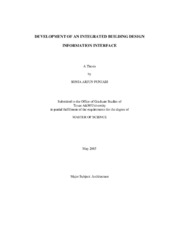| dc.contributor.advisor | Miranda, Valerian | |
| dc.creator | Punjabi, Sonia Arjun | |
| dc.date.accessioned | 2005-08-29T14:38:00Z | |
| dc.date.available | 2005-08-29T14:38:00Z | |
| dc.date.created | 2003-05 | |
| dc.date.issued | 2005-08-29 | |
| dc.identifier.uri | https://hdl.handle.net/1969.1/2296 | |
| dc.description.abstract | This research recognizes the need for building simulation/performance tools that
can easily be integrated into the building design process. The study examines available
simulation tools and attempts to determine why these tools are not used by building
designers/architects. Findings confirm that the complexity of simulation tools created by
scientists, who are more technically oriented, discourages use by architects who are
more visually oriented people.
The evaluation and analysis of available simulation tools suggests a thorough
research methodology for creating a new front-end interface that solves current usage
problems. The research is limited to the interface design of the new front-end which is
named Integrated Building Design Information Interface (IBDII). The new front end
provides an interface that allows designers to make more informed decisions during the
design process while providing a front-end that supports AutoCAD and permits a user
interface where the mode of input is graphical and not numerical.
Criteria for the new front-end interface enable the development of a series of
mock-up interface designs that are responsive to the needs of architects. A working
graphical user interface of the building information prototype is created and is then put
through an empirical user testing. The usability testing establishs the usefulness,
effectiveness, likeability and learnability of the developed interface design. The testing
includes six factors which act as indicators of usability and provide suggestions for
future developments. The testing evaluation ascertains that the interface is easy to learn
and use. Findings also show that the best feature of integrated building design
information front-end is its interface design and there is room for improvement in the
way input is selected. | en |
| dc.format.extent | 1644740 bytes | en |
| dc.format.medium | electronic | en |
| dc.format.mimetype | application/pdf | |
| dc.language.iso | en_US | |
| dc.publisher | Texas A&M University | |
| dc.subject | simulation tools | en |
| dc.subject | building designers | en |
| dc.subject | interface design | en |
| dc.subject | building information | en |
| dc.title | Development of an integrated building design information interface | en |
| dc.type | Book | en |
| dc.type | Thesis | en |
| thesis.degree.department | Architecture | en |
| thesis.degree.discipline | Architecture | en |
| thesis.degree.grantor | Texas A&M University | en |
| thesis.degree.name | Master of Science | en |
| thesis.degree.level | Masters | en |
| dc.contributor.committeeMember | Degelman, Larry | |
| dc.contributor.committeeMember | Rogers, Julie | |
| dc.contributor.committeeMember | Shipman, Frank | |
| dc.type.genre | Electronic Thesis | en |
| dc.type.material | text | en |
| dc.format.digitalOrigin | born digital | en |


